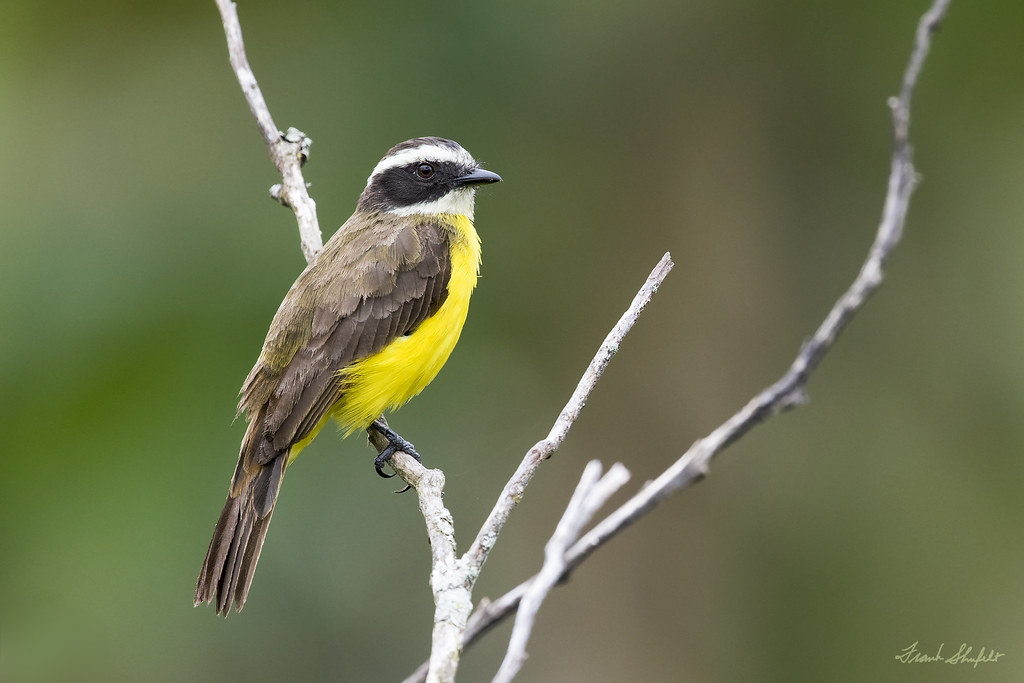The Social Flycatcher! Do not mix this fellow up with the Great Kiskadee that chirps around your windows and backyard. The Social Flycatcher may resemble the Kiskadee but it is unique in its own special way. This brightly colored bird is smaller in size, even its beak is smaller and it is less aggressive than the bold and boisterous Kiskadee. What else can you learn about the Social Flycatcher? Read on to find out.
Features Of The Social Flycatcher
- Head: The head is dark grey with a strong white eye stripe and a usually concealed orange to vermilion crown stripe.
- Upper & Underparts: The upperparts are olive-brown, and the wings and tail are brown with only faint rufous fringes. The underparts are yellow and the throat is white.
- Weight: The adult is 16–18 cm (6.3–7.1 in) long and weighs 24–27 g (0.85–0.95 oz).
- Call: The call is a sharp peeurrr and the dawn song is a chips-k’-cheery.
Tip: Young birds have a paler eye mask, reduced crown stripe, and have chestnut fringes to the wing and tail feathers.
The Social Flycatcher’s Lookalikes
This species looks much like its closest living relative the rusty-margined flycatcher (Myiozetetes cayanensis), and also like the white-bearded flycatcher (Phelpsia inornatus), white-ringed flycatcher (Conopias albovittatus) and lesser kiskadee (Pitangus/Philohydor lictor). In fact, except at close range, these are all but indistinguishable from appearance alone. They and the two larger similar species mentioned above share much of their range. Though they all are apparently fairly close relatives, the group to which they seem to belong also includes species with rather different head-pattern, like the grey-capped flycatcher which also belongs to Myiozetetes.
Did You Know? In appearance, the Social Flycatcher resembles a smaller boat-billed flycatcher or Great Kiskadee.
Scientific Classification Of The Social Flycatcher
Social Flycatcher – Myiozetetes similis [Scienticfic Classification]
- Kingdom: Animalia
- Phylum: Chordata
- Class: Aves
- Order: Passeriformes
- Family: Tyrannidae
- Genus: Myiozetetes
- Species: M. similis
Diet Of The Social Flycatcher
Social flycatchers like to perch openly in trees, several meters above ground. From such perches they will sally out for considerable distances to catch insects in flight, to which purpose they utilize a range of aerobatic maneuvers. They also regularly hover and glean for prey and small berries—e.g. from gumbo-limbo (Bursera simaruba), which they seek out and also utilize in human-modified habitat such as secondary forest or urban parks and gardens – and will pick off prey from the ground and even enter shallow waters to feed on aquatic invertebrates, tadpoles and occasionally small fish. They have been observed to forage peacefully alongside common marmosets (Callithrix jacchus) in the undergrowth, maybe even cooperating with the monkeys in flushing prey from hiding. Perhaps this behavior only occurs during the dry season, when fruits are scarcer; it has been noted that they do not join mixed-species feeding flocks very often.
Reproduction & Habitat Of The Social Flycatcher
The nest of the Social Flycatcher is built by the female in a bush, tree or on a building. It is a large roofed structure of stems and straw, which for protection is often built near a wasp, bee or ant nest, or the nest of another tyrant flycatcher. The nest site is often near or over water. The typical clutch is two to four brown or lilac-blotched cream or white eggs, laid between February and June. They breed in plantations, pasture with some trees, and open woodland from northwestern Mexico south to northeastern Peru, southern Brazil and northwestern Argentina. They can also be found in the forested land of Guyana. They stay on pairs year-round and males look the same as females. It is a common and wide-ranging species and thus not considered threatened by the IUCN.
Five Interesting Facts About The Social Flycatcher
- The Social Flycatcher is similar to other stocky yellow, black and white flycatchers.
- The bird is medium sized with brown upperparts and tail, a short, decurved bill, bold black and white striped head, and yellow underparts that run from the white throat to the undertail coverts.
- The species is easily detected, sits out in the open and gives loud, harsh and sometimes chattering calls. They are often noisy and ‘social’ (some of its calls suggest parakeets); usually found in pairs or small groups, often perching conspicuously.
- They’re common in tropical and subtropical areas, especially in semi-open areas with trees and hedges, woodland edge, towns, gardens.
- They eat a lot of berries, and often occurs alongside Boat-billed Flycatcher and Great Kiskadee in fruiting figs and other trees.
Social Flycatcher In Guyana
The next time you see a yellow, black and white bird, stop and examine which one of the flycatchers it is. You will be amazed when you discern the difference between these birds although they look alike. Guyana is privilege to have these beautiful birds, flying and chirping, in backyards, in trees, around pretty and colorful flowers. They love to lodge on your fence, clothes line and electric wires that run from post to post. Yes, these little yellow fellows are indeed something to look out for!
Article Reference:
- https://en.wikipedia.org/wiki/Social_flycatcher
- https://neotropical.birds.cornell.edu/Species-Account/nb/species/socfly1/overview
- https://ebird.org/species/socfly1
- https://www.costaricabirdingtrips.com/tyranidae/social-flycatcher-myiozetetes-similis
- Main image: https://www.flickr.com/photos/fshufelt/39576066340
Discover more from Things Guyana
Subscribe to get the latest posts sent to your email.







